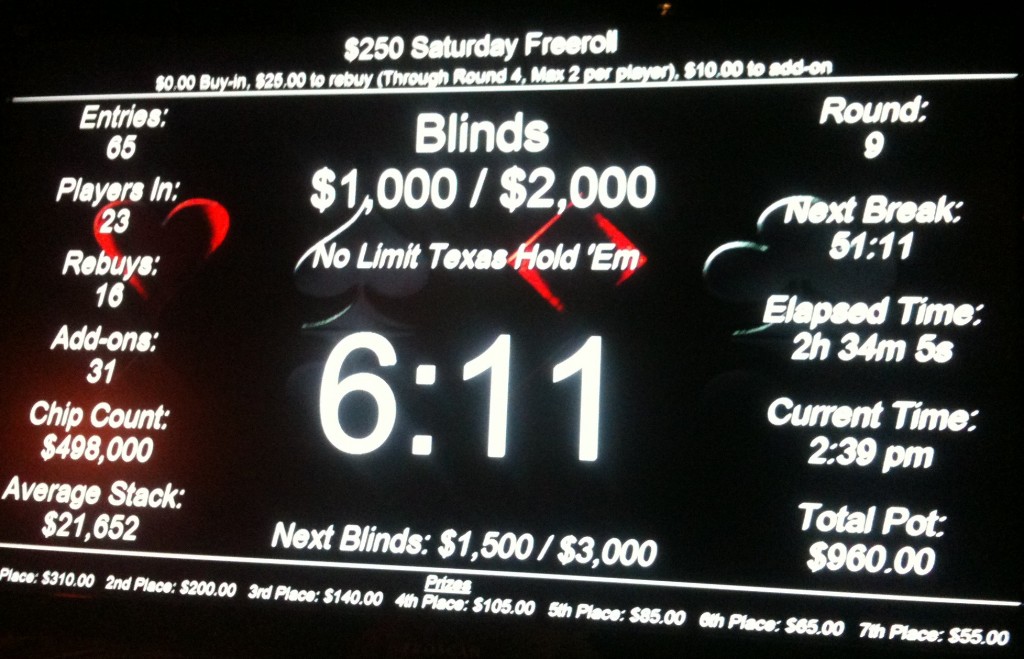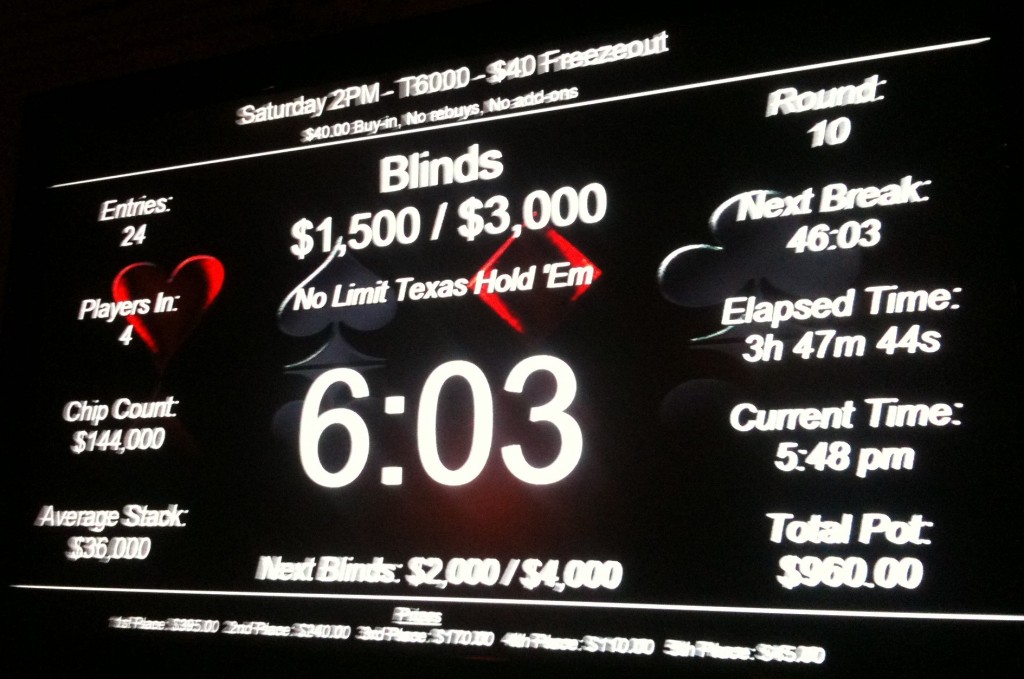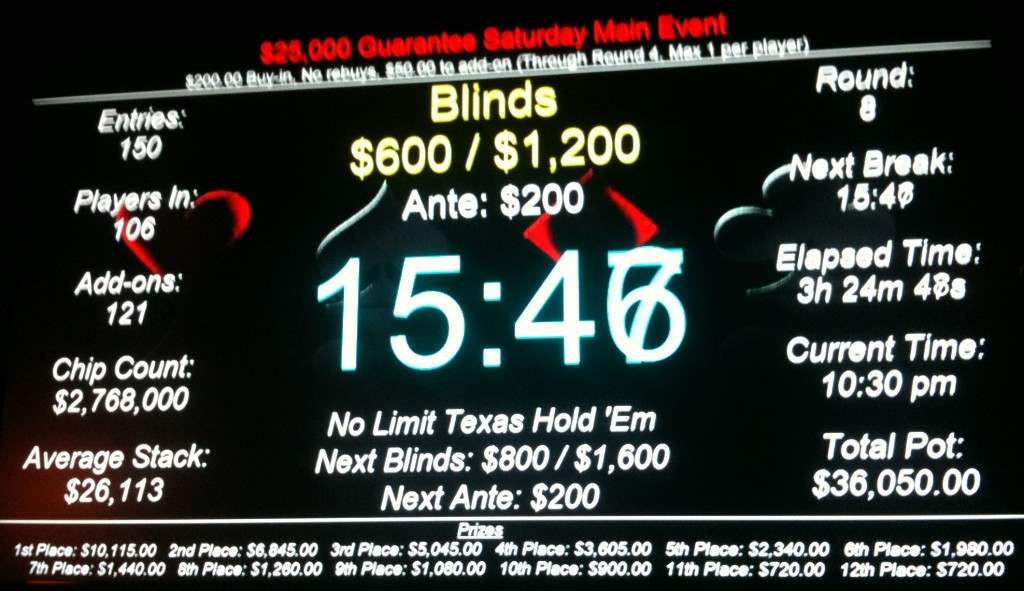Encore Club $25,000 Guarantee Freezeout (12,000 chips)
My best results in tournaments have been at Encore, and I was hoping this game would give my bankroll a little boost before the summer tournament season got into high gear. But like the last Encore $25K, I was gone early.
I quickly lost 450 playing [6x tx], hitting the ten as the high card on the flop and going up against [ax tx]. Just fifteen minutes into the game, I called 600 with [jx tx] and folded to a bet and eventual all-ins on the [4x 9x 3x] flop. [kx] turn card was the one the eventual winner wanted to see, because it gave him a higher set than the [9x 9x] of the original bettor, but [qx] on the river would have made my straight the best hand.
I stuck it out to the end with straight and flush draws on [5h 8h] but didn’t get there, and twenty minutes into the game I was already down to 9,300. I slid another 1,100 down the drain with [ax 2x] drawing to a wheel.
[ax 2x] on BTN lost me chips again when I two pairs came on the board but my opponent made a full house with a full house. Half an hour and I was nearly 5,000 chips.
Finally, I won a pot with [kd td], hitting two diamonds and a ten-high flop, with another diamond on the turn, gaining about 2,000 chips.
I bided my time and lost the ground I’d regained with a missed nut flush draw and [as 9s]. Then I busted a short(er) stack with [8x 8x] against [ax qx], turned around and lost 1,200 on the next hand calling with [jx 9x]. I hit middle pair but folded to a post-flop bet. Even with the knockout I only had 8,725 chips just before the first hour ended.
Right on the hour mark, I was BB and picked up [kx kx]. There was a raise and several calls ahead of me but I wanted to get value and just called. Unfortunately, while the flop gave me top set, it was entirely diamonds. A player at the other end of the table bet 1,000, SB called, and I shoved with about 7,500 left, hoping that I might scare off a weak flush or flush draw, or that I could catch a board pairing to make my full house. The original post-flop bettor folded but SB called with [ad 9d], the last two cards didn’t pair the board, and I was out on the hour.
One hour. Alternates were still being seated.
The Final Table $1,000 Guarantee (7,000 chips)
I took the poison pot on the first hand with [5x 7x], making two pair by the turn. I bet 200 and got two calls. Two queens rolled out on the turn and river, counterfeiting my fives, but my two pair was still the best and I won.
Called 250 pre-flop with [jh 8h] and called the re-raise to 450 but with a [9x 8x 6x] flop I folded to the next bet.
A [3x 4x] in the BB made it to the flop and paired the four. Suited cards started to show up and by the river I had a baby flush with the trey. A small bet seemed to be enough for everyone else, because I won. All that, and a dozen minutes into the game I was up a grand total of 300 chips.
Then I got [kx jx] and blew 1,150 drawing for a queen to make Broadway, putting me down 900 from the starting stack twenty minutes in.
With [5x 5x] in SB, I called a 150 bet post-flop but folded after the turn when there were four overs. I got a little of it back with [kx jx], betting at a [jx 2x 2x] flop. I was sliding, though, with 6,050 at the half-hour mark, and 5,650 five minutes later.
With [jc 2c], I called a pre-flop raise to 250 along with three others. The flop was [ax 3x ax] and I bet at it, bluffing everyone off the hand.
Called a 250 raise with [3d 6d] and got an open-ended straight draw with a flop of [kx 4x 5x]. Went out on a limb calling a post-flop re-raise of 1,750 but was rewarded with a [2x] on the turn. I shoved and was called by [kx 8x], which finally put me over the starting stack again, with 13,750 at 50 minutes into the game.
Taking notes on that hand, I didn’t notice action come around to me on the next as BTN and I was flustered enough by the two all-ins ahead of me that when I looked at [ax kx] I folded it rather than get into what looked to be a bloody battle. I figured it was likely a couple of players had aces, I would have been putting most of my stack (if not all) at risk, so I thought not. I should have throughout it through, better, though. As it was, none of the players had premium hands, none of them had anything higher than a king, and it was a pair of kings in the hand of the guy I’d just doubled up against that took the pot. I’d had all three stacks covered. My ace kicker would have taken out three players. Another instance of failing to pull the trigger.
I called 1,100 with [qx 9x] but folded it to a post-flop bet, then put in another 825 on [ks 3s] to call a raise and had to fold to 2 all-in pre-flop bets.
Raised to 600 from BTN with [ad 3d] and got called by the blinds to see a [8x 7x qx] flop. A bet of 700 won the pot and put me at 12,700 just past the one-hour mark. Then I lost just about everything with [8s ts] when my eight paired the top card on the board and I fell to a set of fives. I was done in when [ax tx] called my all-in with [ax jx].
One hour and twelve minutes. 21st of 27 entries.



